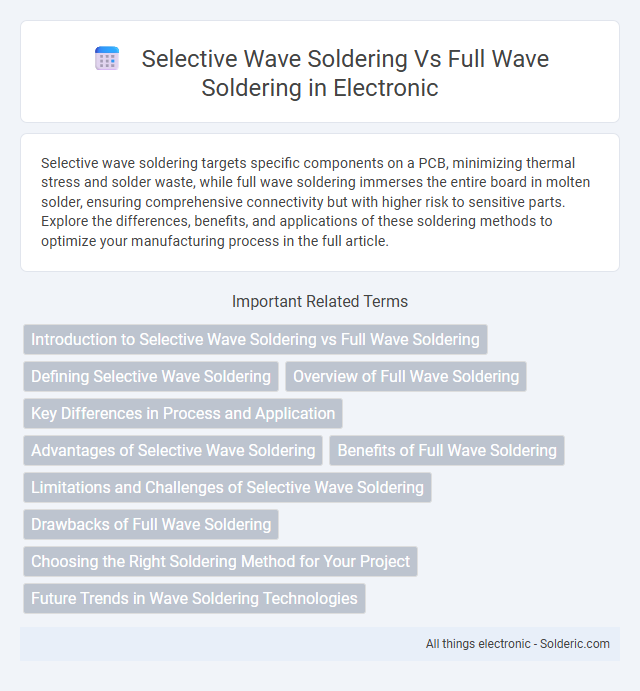Selective wave soldering targets specific components on a PCB, minimizing thermal stress and solder waste, while full wave soldering immerses the entire board in molten solder, ensuring comprehensive connectivity but with higher risk to sensitive parts. Explore the differences, benefits, and applications of these soldering methods to optimize your manufacturing process in the full article.
Comparison Table
| Feature | Selective Wave Soldering | Full Wave Soldering |
|---|---|---|
| Process | Targets specific areas of PCB with solder wave | Entire PCB surface exposed to solder wave |
| Application | Used for mixed technology PCBs, selective components | Used mainly for through-hole PCBs with uniform components |
| Soldering Precision | High precision, minimizes solder bridges and shorts | Lower precision, risk of solder bridges on sensitive parts |
| Throughput | Moderate, process time depends on selective areas | High, faster for mass production of uniform boards |
| PCB Size & Complexity | Suitable for complex and multi-layer boards | Best for simple, single-layer or dual-layer boards |
| Cost | Higher setup and maintenance costs due to complexity | Lower cost per unit for large volume production |
| Defect Rate | Lower risk of component damage and defects | Higher risk of defects, especially with mixed components |
Introduction to Selective Wave Soldering vs Full Wave Soldering
Selective wave soldering targets specific components on a printed circuit board (PCB) using a focused solder wave, minimizing heat exposure and preventing damage to sensitive parts. Full wave soldering immerses the entire PCB in a continuous wave of molten solder, enabling rapid processing but increasing the risk of solder bridging and thermal stress. Your choice between these methods depends on PCB complexity, component sensitivity, and production volume requirements.
Defining Selective Wave Soldering
Selective wave soldering uses a controlled solder wave to target specific areas on a printed circuit board (PCB), enabling precise component soldering without exposing the entire board to the solder. This method contrasts with full wave soldering, where the entire PCB passes over a continuous wave, resulting in broader solder coverage. Selective wave soldering improves efficiency and quality in assemblies with mixed through-hole and sensitive surface-mount components.
Overview of Full Wave Soldering
Full wave soldering involves immersing an entire printed circuit board (PCB) into a molten solder bath, ensuring simultaneous soldering of all exposed conductive surfaces. This method guarantees consistent solder joints across through-hole components but can lead to excessive solder on areas not intended for soldering. Full wave soldering is typically suited for high-volume manufacturing where board design and components can withstand full immersion without damage.
Key Differences in Process and Application
Selective wave soldering targets specific areas of a printed circuit board (PCB) by using a controlled, localized wave of molten solder, ideal for mixed technology boards where only certain components require soldering. Full wave soldering involves passing the entire PCB over a continuous wave of solder, suitable for through-hole components on single-layer or multilayer boards with uniform soldering demands. The key differences lie in precision and efficiency: selective wave soldering minimizes thermal stress and solder waste, while full wave soldering offers speed and consistency for high-volume, uniform assemblies.
Advantages of Selective Wave Soldering
Selective wave soldering offers precise solder application by targeting specific areas on a PCB, reducing the risk of thermal damage to sensitive components. Your production process benefits from lower solder waste and improved quality control, as this method minimizes solder bridging and defects. Compared to full wave soldering, selective wave is ideal for complex assemblies with mixed through-hole and surface-mount components, enhancing efficiency and reliability.
Benefits of Full Wave Soldering
Full wave soldering ensures consistent and thorough solder coverage across all PCB joints, significantly reducing the risk of cold solder joints and improving overall electrical connectivity. This method enhances production efficiency by enabling faster throughput and minimizing the need for rework compared to selective wave soldering. Your manufacturing process benefits from increased reliability and uniformity in solder joints when utilizing full wave soldering.
Limitations and Challenges of Selective Wave Soldering
Selective wave soldering faces limitations such as restricted throughput compared to full wave soldering due to the need for precise nozzle control and slower processing speeds. Challenges include ensuring accurate solder application on complex PCB assemblies with varying component heights, which can lead to insufficient or excessive solder joints. Additionally, maintenance of expensive, specialized equipment and the potential for nozzle clogging impact process reliability and increase operational costs.
Drawbacks of Full Wave Soldering
Full wave soldering often leads to increased thermal stress on components due to prolonged exposure to molten solder, potentially damaging sensitive devices and reducing overall reliability. The process tends to consume more solder and flux, resulting in higher material costs and environmental waste compared to selective wave soldering. Additionally, full wave soldering lacks precision, increasing the risk of solder bridges and defects on densely populated printed circuit boards (PCBs).
Choosing the Right Soldering Method for Your Project
Selective wave soldering targets specific areas on a printed circuit board (PCB), minimizing thermal stress and reducing solder bridging, making it ideal for mixed technology boards with sensitive components. Full wave soldering immerses the entire PCB in solder, providing uniform coverage and high throughput, best suited for large production runs with through-hole components. Choosing the right soldering method depends on board complexity, component sensitivity, production volume, and cost considerations to ensure optimal solder joint quality and manufacturing efficiency.
Future Trends in Wave Soldering Technologies
Selective wave soldering continues to evolve with advancements in precision robotics and adaptive process controls, enabling higher efficiency for complex PCB assemblies. Full wave soldering trends emphasize environmentally friendly flux formulations and thermal profiling innovations to reduce defects and improve joint reliability. Both technologies increasingly integrate real-time monitoring systems powered by AI to optimize soldering parameters and minimize material waste.
Selective wave soldering vs full wave soldering Infographic

 solderic.com
solderic.com